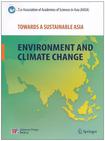通向可持续发展的亚洲
2010-1
亚洲科学院协会 科学出版社 (2010-01出版)
亚洲科学院协会 编
103
无
Diverse landscape and culture, dense population, rapid economic growth,world manufacturer center, those are all about Asia, the most economicallydynamic region in the world. In the past two decades, most Asia countries haveexperienced major booming in industrial and agricultural production, alongwith fundamental changes in lifestyle and consumption patterns. While Asiancountries produce more and higher quality products for world markets, morepeople than any other continent have walked out of the shadow of poverty.However, environmental change and deterioration are also highly evident as Asiaregional economy continued to grow at a high rate. Under combined pressureof climatic change and human disturbances, the natural environment in Asiahas been steadily degrading, which compromises the future development andthe livelihood of its 3.8 billion residents. Meanwhile, share of Asian developingcountries to global GHG emissions is rising rapidly. Impacts of climate changeare especially visible in Asian various sectors including agriculture, forestry,biodiversity conservation, water resources, human health, air quality, energysecurity, etc. Impacts of climate change in Asia are already serious, and will verylikely further worsen in future. Environmental sustainability is under seriousthreat.This report of the Association of Academies of Sciences in Asia (AASA)aims to investigate the common environmental problems that threaten humanlivelihood and compromise sustainable future in Asia where we are in the sameboat facing global climate change and environmental degradation. This reportintends to provide governments and general public with up-to-date informationon ongoing and future environmental changes, with guidelines of best practicesof adaptation and mitigation by scaling-up of useful local and nationalexperiences to regional level, and with regional overview/recommendations ofenvironmental policies. It is designed to cover the entire continent, with fourfoci units: coastal Asia, dryland Asia, highland Asia, and urban Asia. The reportof environment and climate change covers the following schemes:
This series of books are the output of the research project called "Sustainable Development in Asia (SDA)", which was initiated by the Association of Academies of Sciences in Asia (AASA). They are comprised of one synthesis report, which entitled Towards a Sustainable Asia: Green Transition and Innovation, and four thematic reports on natural resources, energy, the environment and climate change, and culture from particular perspectives of agriculture. They aim to: 1) investigate common sustainability issues faced by all Asian countries, including population increase, poverty alleviation, pollution control, ecological restoration, as well as regional problems, such as water shortage in West and Central Asia, energy security in Northeast Asia, development model & transformation in East Asia; 2) analyze and summarize of best practices towards sustainable development in Asia; 3) bring forward suggestions and policy options for promoting green transition, system innovation and sustainable development of Asia. With best practice guidelines for a sustainable Asia, this series of reports, for the first time systematically address the common challenges and regional problems in regard to Asia's natural resources use, pollution reduction and climate protection, sustainable energy development, and innovations for environment-friendly and culture-compatible agriculture. They will provide handy and useful information to researchers, government policy makers and the general public who have concerns about Asia's sustainable development. AASA is a scientific and technological organization in Asia, established in 2000, comprising of 26 member academies all over Asia. Its vision is to provide a forum for the discussion of all issues relevant to science and technology development and its application on national level within Asia.
1.Environmental Issues in Asia:States and Trends1.1 Key environmental issues in Asia: a big picture1.2 Atmosphere1.3 Water1.4 Regional climate change1.5 Climate extremes and natural disasters2.Sensitivity and Vuinerability Across Asia-Ecpregional Perpective2.1 Dryland (Arid and semi-arid areas)2.2 Highland areas2.3 Coastal areas2.4 Urban areas3.Challenges and Opportunities for Better Environment3.1 Key problems3.2 Responses and actions from various sectors3.3 Solution and strategies based on local knowledge4.Environmental and Climate Change Policies Towards Sustainability4.1 overview of national regulations and regional cooperation4.2 Lessons and progresses from past decade4.3 Going forward
插图:Another important aspect of the subsurface environment concernsmaterial (contaminant) transport to the coast. Since most Asian megacities arelocated on the coast, material and contaminant transport by groundwater isa key to understanding present and future coastal water pollution and effectson associated ecosystems (Capone and Bautista, 1985). While the overallflow of fresh groundwater into the ocean is likely no more than about 6% ofriver runoff, it has been estimated that the total dissolved salt contributed byterrestrially-derived submarine groundwater discharge may reach as much as50% of that contributed by rivers (Zektser and Loaiciga, 1993). This process willthus affect the biogeochemistry of estuaries and the coastal ocean through theaddition of nutrients, metals, and carbon (Hwang et al., 2005). In addition toinputs of terrestrially-derived groundwater, recirculation of seawater throughsediments by tidal pumping and other processes can also provide significantbiogeochemical inputs and is also considered "submarine groundwaterdischarge" (Li et al., 1999; Burnett et al., 2003).The biogeochemical importance of groundwater discharge to the coastalocean is dependent on several variables, including the amount and type of nutrientenrichment, water column circulation and tidal flushing, and the groundwater flowrate, which is determined by the porosity and permeability of the underlying strataand the hydraulic head. During the passage of terrestrially-derived fluids throughsediments in a coastal aquifer, mixing of seawater with fresh groundwater andchemical reactions of the fluids with solid phases wil occur. Thus, the emergingfluid is often chemically distinct from both the groundwater and seawaterendmembers. Concentrations of nutrients, trace metals, organic carbon, and othercomponents may be considerably higher than coastal ocean waters. Groundwatermay have nutrient concentrations several orders of magnitude greater than surfacewaters either from contamination sources or natural processes.
《通向可持续发展的亚洲:环境与气候变化(英文版)》是由科学出版社出版的。

无